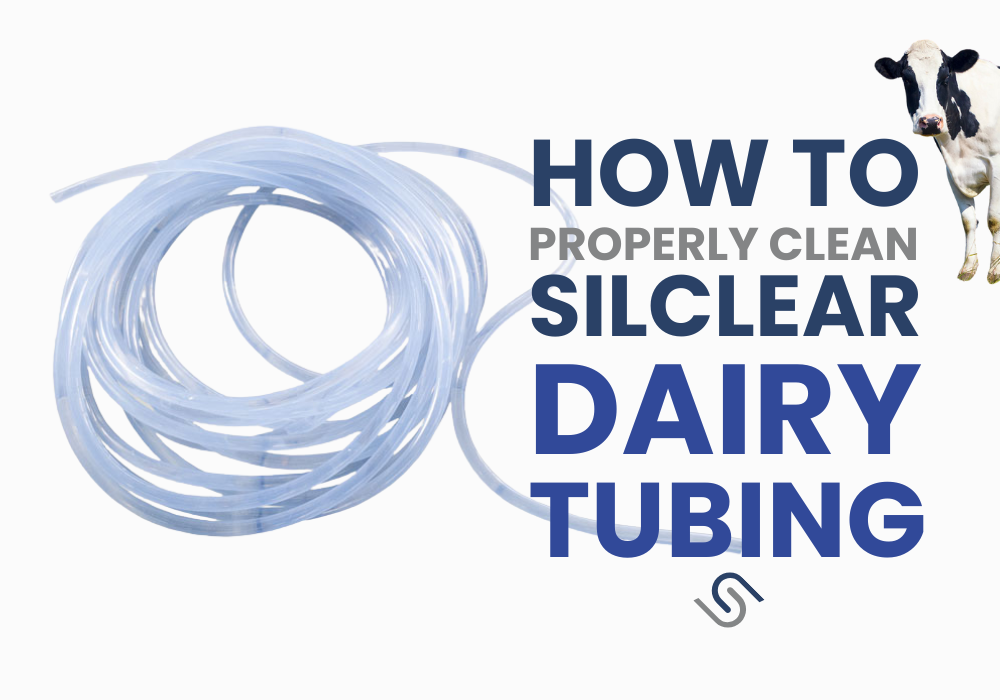Keeping your silicone dairy tubing clean is essential for protecting milk quality, ensuring animal welfare, and extending the life of your equipment. Silclear’s high-performance silicone tubing is designed to handle daily cleaning routines and withstand the harsh conditions of milking environments. But like any part of your dairy system, it needs to be properly maintained.
This guide explains how to clean silicone dairy tubing, including daily internal and external procedures, periodic deep cleans, and tips for tackling milk stone build-up and vacuum system contamination.
Why Regular Cleaning Matters
Silicone offers excellent resistance to heat, chemicals, and UV, making it a durable and hygienic choice for milking systems. However, without correct cleaning routines, even the best tubing can harbour fat residues, milk deposits or biofilm, leading to hygiene issues, poor milk results, and shortened product life.
Daily Cleaning Routine for Silicone Dairy Tubing
Silclear tubing is compatible with standard CIP (clean-in-place) routines. Here’s how to clean it internally and externally:
External Cleaning
- Hose down surfaces to remove visible dirt or debris.
- Wash the outside with a warm detergent-disinfectant solution to remove fat and residue.
- Rinse thoroughly with clean water.
Internal Cleaning
- Rinse the system with water to flush out milk residues.
- Draw hot water through the system until the discharge temperature reaches at least 50°C.
- Perform a hot re-circulation wash using a detergent sanitiser at the correct dilution rate (follow your chemical supplier’s guidance).
-
- Ensure water in the heater is at least 5°C hotter than the start temperature to allow for heat loss.
- Begin circulation at the top of the recommended temperature range.
- Discharge the solution before it drops below the minimum recommended temperature
4. Finish with a cold water rinse containing an approved hypochlorite disinfectant (25ml to 40 litres of water).
Top tip: It’s better to clean for slightly less time at the correct temperature than to clean longer at a lower one. Cool washes redeposit fat and compromise hygiene.
Periodic Deep Cleaning and Reconditioning
For long-term performance and optimal hygiene, Silclear tubing should be periodically reconditioned using washing soda crystals (sodium carbonate decahydrate), not caustic soda.
How to Perform a Reconditioning Soak
- Dissolve 1kg of washing soda crystals per 10 litres of water (80°C to 100°C).
- Fully immerse the silicone tubing and fittings.
- Agitate every few minutes while soaking.
- Remove parts before the solution drops below 50–55°C.
- Rinse thoroughly with hot water and allow to dry fully.
- Before reinstalling, ensure all grease and residue is removed from any metal or plastic fittings.
Washing soda is not only effective at lifting residues, it also acts as an anti-virulent and helps restore tubing appearance.
Additional Hygiene Measures
- Milk stone removal: Use a proprietary remover every 2–3 weeks (or weekly in hard water areas).
- Vacuum system cleaning: Wash monthly with a hot, non-foaming detergent-sanitiser and follow with a hot rinse.
- Heat disinfection: If the plant appears clean but hygiene results are poor, perform a heat disinfection using water heated to 90°C, circulating as usual once the temperature drops to 65°C.
Appearance Notes
Discolouration from iodine, black rubber, or manure may occur over time. While this may change the appearance of your tubing, it does not affect performance. Teat dips containing chlorhexidine typically do not cause staining.
Get More from Your Silicone Dairy Tubing
Proper cleaning not only protects your herd and your product, it also helps your Silclear silicone tubing last longer and perform at its best.
For more advice on caring for your silicone parts or to order new tubing, contact our team on +44 (0)1425 610700, email info@silclear.com or enquire below.
Enquire about Silicone Tubing & Cleaning
Fill out the form below and we’ll be in touch to discuss your requirements.
“*” indicates a required field.
